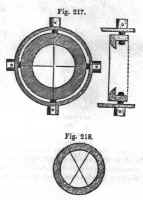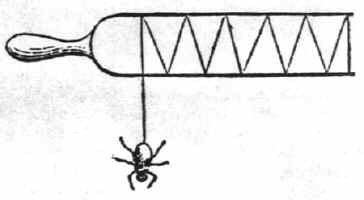|
 Article taken from "Backsights"
Magazine published by Surveyors Historical Society
Article taken from "Backsights"
Magazine published by Surveyors Historical Society
|
From A Treatise on Land
Surveying, by W. M. Gillespie, New York 1870
Since a considerable field of view is
seen in looking through a Telescope, it is necessary to provide means for
directing the line of sight to the precise point which is to be
observed. This could be effected by placing a very fine point, such
as that of a needle, within the Telescope, at some place where it could be
distinctly seen. In practice this fine point is obtained by the
intersection of two very fine lines, placed in the common focus of the
object-glass and of the eye-piece. These lines are called the cross-hairs,
or cross-wires. Their intersection can be seen through the eye-piece, at
the same time, and apparently at the same place, as the image of the distant
object. The magnifying powers of the eye-piece will then detect the
slightest deviation from perfect coincidence. "This application of
the Telescope may be considered as completely annihilating that part of the
error of observation which might arise from an erroneous estimation of the
direction in which an object lies from the observer's eye, or from the center of
the instrument. It is, in fact, the grand source of all the precision of
modern Astronomy, without which all other refinements in instrumental
workmanship would thrown away." What Sir John Herschel here says of
its utility to Astronomy, is equally applicable to Surveying.
The imaginary line which passes through
the intersection of the cross-hairs and the optical center of the object-glass,
is called the line of collimation of the Telescope.*
 The
cross-hairs are attached to a ring, or short thick tube of brass, placed within
the Telescope tube, through holes in which pass loosely four screws, whose
threads enter and take hold of the ring, behind or in front of the cross-hairs. The
cross-hairs are attached to a ring, or short thick tube of brass, placed within
the Telescope tube, through holes in which pass loosely four screws, whose
threads enter and take hold of the ring, behind or in front of the cross-hairs.
Usually, one cross-hair is horizontal,
and thother vertical as in Fig. 217, but sometimes they are arranged as in Fig.
218, which is thought to enable the object to be bisected with more
precision. A horizontal hair is sometimes added.
 The
cross-hairs are best made of platinum wire, drawn out very fine by being
previously enclosed in a larger wire of silver, and the silver then removed by
nitric acid. Silk threads from a cocoon are sometimes used. Spiders'
threads are however, the most usual. If a cross-hair is broken, the ring
must be taken out by removing two opposite screws, and inserting a wire with a
screw cut on its end, or a stick of suitable size, into one of the holes thus
left open in the ring, it being turned sideways for that purpose, and then
removing the other screws. The spider's threads are then stretched across
the notches seen in the end of the ring, and are fastened by gum, or varnish, or
beeswax. The operation is a very delicate one. The following plan
has been employed. A piece of wire is bent, as in the figure, so as to
leave an opening a little wider than the ring of the cross-hairs. A cobweb
is chosen, at the end of which a spider is hanging, and its wound around the
bent wire, as in the figure, the weight of the insect keeping it tight and
stretching it ready to use, each part being made fast by gum, &c. When
a cross-hair is wanted, one of these is laid across the ring and there
attached. Another method is to draw the thread out of the spider,
persuading him to spin, if he sulks, by tossing him from hand to hand. A
stock of such threads must be obtained in warm weather for the winter's
wants. A piece of thin glass, with a horizontal and a vertical line etched
on it, may be made a substitute. The
cross-hairs are best made of platinum wire, drawn out very fine by being
previously enclosed in a larger wire of silver, and the silver then removed by
nitric acid. Silk threads from a cocoon are sometimes used. Spiders'
threads are however, the most usual. If a cross-hair is broken, the ring
must be taken out by removing two opposite screws, and inserting a wire with a
screw cut on its end, or a stick of suitable size, into one of the holes thus
left open in the ring, it being turned sideways for that purpose, and then
removing the other screws. The spider's threads are then stretched across
the notches seen in the end of the ring, and are fastened by gum, or varnish, or
beeswax. The operation is a very delicate one. The following plan
has been employed. A piece of wire is bent, as in the figure, so as to
leave an opening a little wider than the ring of the cross-hairs. A cobweb
is chosen, at the end of which a spider is hanging, and its wound around the
bent wire, as in the figure, the weight of the insect keeping it tight and
stretching it ready to use, each part being made fast by gum, &c. When
a cross-hair is wanted, one of these is laid across the ring and there
attached. Another method is to draw the thread out of the spider,
persuading him to spin, if he sulks, by tossing him from hand to hand. A
stock of such threads must be obtained in warm weather for the winter's
wants. A piece of thin glass, with a horizontal and a vertical line etched
on it, may be made a substitute.
* From the Latin work "collimo",
or "collineo", meaning to direct one thing towards another in a
straight line, or to aim at. The "line of aim" would express the
meaning.
|
